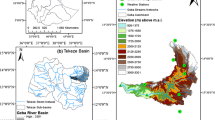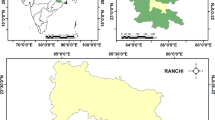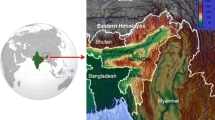Abstract
The historical rainfall data of 110 years (1901–2010) of the two neighbouring basins of Brahmaputra and Barak of Assam, Northeast India were analyzed for monthly, seasonal and annual trends. The Mann–Kendall test and Sen’s slope model were used to identify the trends and estimate the magnitude of change, respectively. The analysis revealed significant decreasing trend of rainfall during monsoon and post-monsoon seasons in the Barak basin during 1901–2010. Annual as well as monsoon rainfall during the recent 30-year normal period decreased significantly in both the basins. The last decade (2001–10) was the leanest decade in both the basins. Recent rainfall fluctuations with larger amplitudes indicate greater degree of uncertainties of heavy floods or short spell drought events.








Similar content being viewed by others
References
Ashok K, Saji NH (2007) On the impacts of ENSO and Indian Ocean dipole events on sub-regional Indian summer monsoon rainfall. Nat Hazards 42:273–285
Attri SD, Tyagi A (2010) “Climate profile of India”. IMD Met Monograph No. Environmental Meteorology-01/2010. 3–4pp.
Barthakur M et al (2004) Weather and Climate. In: Singh VP (ed) “The Brahmaputra Basin Water Resources”. Kluwer, The Netherlands, p 22
Dash SK, Jenamani RK, Kalsi SR, Panda SK (2007) Some evidence of climate change in twentieth-century India. Climatic Change 85:299–321
Dhar ON, Nandargi S (2000) A study of floods in the Brahmaputra basin in India. Intl J Climatol 20:771–781
Dhar ON, Nandargi S (2003) Hydrometeorological aspects of floods in India. Nat Hazards 28:1–33
Dhar ON, Mandal BN, Rakhecha PR (1984) Rainfall distribution over India during the monsoon months in the absence of depressions and cyclonic storms. Mausam 35(3):309–314
Gadgil SP, Vinayachandran PN, Francis P, Gadgil S (2004) Extremes of the Indian summer monsoon rainfall, ENSO and equatorial Indian Ocean oscillation. Geophys Res Lett 31:L12213. doi:10.1029/2004GL019733
Gilbert RO (1987) Statistical methods for environmental pollution monitoring. Van Nostrand Reinhold, New York
Goswami DC (1998) Fluvial regime and flood hydrology of the Brahmaputra river, Assam. In: Kale, V. S. (Ed.) Flood studies in India, Memoir No. 41 of the Geological Society of India, Bangalore, pp. 53–75
Goswami BB, Mukhopadhyay P, Mahanta R, Goswami BN (2010) Multiscale interaction with topography and extreme rainfall events in the northeast Indian region. J Geophysical Res 115:D12114. doi:1029/2009JD012275
Guhathakurta P, Rajeevan M (2008) Trends in rainfall pattern over India. Intl J Climatol 28:1453–1469
Hamed KH (2008) Trend detection in hydrologic data: the Mann–Kendal trend test under the scaling hypothesis. J Hydrol 349:350–363
Hasanean MH (2001) Fluctuations of surface air temperature in the Eastern Mediterranean. Theor Appl Climatol 68:75–87
Helsel DR, Hirsch RM (1992) Statistical methods in water resources. Elsevier, Amsterdam, The Netherlands
IPCC (2007) Climate change 2007: the physical science basis. Summary for policymakers. Contribution of Working Group I to the Fourth Assessment Report of the Intergovernmental Panel on Climate Change.
Jadav SK, Munot AA (2009) Warming SST of Bay of Bengal and decrease in formation of cyclonic disturbances over the Indian region during southwest monsoon season. Theor Appl Climatol 96:327–336
Jain SK, Agarwal PK, Singh VP (2007) Hydrology and water resources of India, 1st edn. Kluwer, The Netherlands, pp 428–430
Kale V (2011) On the link between extreme floods and excess monsoon epochs in South Asia. Clim Dyn. doi:10.1007/s00382-011-1251-6
Kothawale DR, Kulkarni JR (2012) Indian monsoon rainfall variability in warming scenario over Indian continent. Proceedings of International conference on Opportunities and Challenges in Monsoon Prediction in a Changing Climate (OCHAMP-2012), Pune India
Kothawale DR, Munot AA, Borgaonkar HP (2008) Temperature variability over the Indian Ocean and its relationship with Indian summer monsoon rainfall. Theor Appl Climatol 92:31–45
Kripalani RH, Kulkarni A, Sabade SS, Khandekar ML (2003) Indian monsoon variability in a global warming scenario. Nat Hazards 29:189–206
Krishnamurthy V, Goswami BN (2000) Indian monsoon–ENSO relationship on inter decadal time scale. J Clim 13:579–771
Kumar V, Jain SK, Singh Y (2010) Analysis of long-term rainfall trends in India. Hydrol Sci J 55:484–496
Luo Y, Liu S, Fu S, Liu J, Wang G, Zhou G (2008) Trends of precipitation in Beijiang River Basin, Guangdong province, China. Hydrol Process 22:2377–2386
Mandke SK, Bhide VU (2003) A study of decreasing storm frequency over Bay of Bengal. J Ind Geophys Union 7(2):53–58
Mirza MMQ, Warrick RA, Ericksen NJ, Kenny GJ (1998) Trends and persistence in precipitation in the Ganges, Brahmaputra and Meghna basins in South Asia. Hydrol Sci J 43(6):845–858
Mirza MMQ, Warrick RA, Ericksen NJ, Kenny GJ (2001) Are floods getting worse in the Ganges, Brahmaputra and Meghna basins? Environmental Hazards 3:37–48
Mitchell JM, Dzeedzeevskii B, Flohn H, Hofmeyr WL, Lamb HH, Rao KN, Wallen CC (1966) Climatic change, WMO Tech Note 79. WMO No. 195. TP-100 Geneva, 79pp
Ojha CSP, Singh VP (2004) Introduction. In: Singh VP, Sharma N, Ojha CSP (eds) The Brahmaputra basin water resources. Kluwer, The Netherlands, pp 1–15
Pant GB, Rupa Kumar K (1997) Climates of South Asia. Wiley, Chichester, UK, 320
Partal T, Kahya E (2006) Trend analysis in Turkish precipitation data. Hydrol Process 20:2011–2026
Pearson E, Hartley HO (1958) Biometrica tables for statisticians, 2nd edn. Cambridge University Press, New York
Ramesh Kumar MR, Krishnan R, Sankar S, Unnikrishnan AS, Pai DS (2009) Increasing trend of break monsoon conditions over India—role of ocean–atmosphere processes in the Indian Ocean. IEEE Geosci Remote Sens Lett 6(2):332–336
Ranade A, Singh N, Singh HN, Sontakke NA (2008) On variability of hydrological wet season, seasonal rainfall and rain water potential of the river basins of India (1813–2006). J Hydrol Res Dev 23:79–108
Rupa Kumar K, Krishna Kumar K, Ashrit RG, Patwardhan SK, Pant GB (2002) Climate Change in India: Observations and model projections. In: Shukla PR, Sharma SK, Ramana PV (eds) Climate change and India: issues, concerns and opportunities. McGraw-Hill, New Delhi, pp 24–75
Sen PK (1968) Estimates of the regression coefficient based on Kendall’s tau. J Am Stat As 63:1379–1389
Sen Roy S, Balling JR (2004) Trends in extreme daily precipitation indices in India. Intl J Climatol 24:457–466
Sikka DR (2006) A study on the monsoon low pressure systems over the Indian region and their relationship with drought and excess monsoon rainfall. Centre for Ocean–Land–Atmosphere Studies, Centre for the Application of Research on the Environment, Calverton, MD
Singh P, Kumar V, Thomas T, Arora M (2008) Changes in rainfall and relative humidity in river basins in northwest and central India. Hydrol Processes 22(16):2982–2992. doi:10.1002/hyp.6871
WMO (1966) Climate Change. WMO Tech. Note, No.79, WMO No. 195-TP-100, Geneva.80
WMO (1989) Calculation of monthly and annual 30-year standard normals. WCDP, No.10, WMO-TD/No.341, Geneva.
Acknowledgement
Authors are grateful to the Regional Meteorological Centre (India Meteorological Department), Guwahati, Assam for providing the data used in this study. Authors are also grateful to the anonymous reviewer for the critical review, which helped in improving the quality of the paper.
Author information
Authors and Affiliations
Corresponding author
Rights and permissions
About this article
Cite this article
Deka, R.L., Mahanta, C., Pathak, H. et al. Trends and fluctuations of rainfall regime in the Brahmaputra and Barak basins of Assam, India. Theor Appl Climatol 114, 61–71 (2013). https://doi.org/10.1007/s00704-012-0820-x
Received:
Accepted:
Published:
Issue Date:
DOI: https://doi.org/10.1007/s00704-012-0820-x




